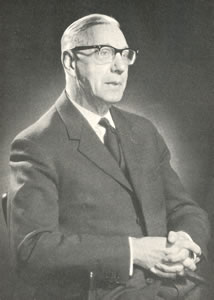Alfred Fairbank | |
|---|---|
 | |
| Born | 12 July 1895 Grimsby, Lincolnshire, England |
| Died | 14 March 1982 (aged 86) |
| Education | Central School of Art and Design |
| Known for | Calligraphy, Handwriting, Palaeography |
| Style | Italic Script |
| Parents |
|
| Relatives | Elsie Kneeshaw |
| Website | fairbankcalligraphysociety |
Alfred John Fairbank CBE (12 July 1895 – 14 March 1982) was a British calligrapher, palaeographer and author on handwriting.[1][2]
Fairbank was a founding member of the Society of Scribes and Illuminators in 1921, and later became its honourable secretary.[3] He was involved in the foundation of the Society for Italic Handwriting in 1952; his work and 1932 textbook A Handwriting Manual were influential on the italic script handwriting taught in British schools.[4][5] His portrait was painted by Anna Hornby.[6][7] For Penguin Books he wrote A Book of Scripts, on handwriting styles.[8]
Fairbank was a civil servant who spent his professional career working at the Admiralty in London and Bath; he retired to Hove on the south coast and lectured at what is now the University of Brighton after his retirement.[9][10][11][12] Fragments from medieval manuscripts collected by Alfred Fairbank are located at the Cadbury Research Library of the University of Birmingham.[13]
- ^ "Alfred Fairbank" (PDF). Klingspor Museum. Retrieved 14 May 2016.
- ^ "Obituary". The New York Times. 9 April 1982. Retrieved 15 May 2016.
- ^ "Former Chairmen". The Society of Scribes and Illuminators. Retrieved 14 May 2016.
At the instance of Stanley Morison, he [Fairbank] designed in 1928 the elegant compact typeface known as Narrow Bembo, a title he detested.
- ^ "Society for Italic Handwriting – History". Society for Italic Handwriting. Retrieved 14 May 2016.
- ^ Sassoon, Rosemary (2007). Handwriting of the Twentieth Century. Intellect Books. pp. 71–5. ISBN 978-1-84150-178-9.
- ^ "Papers of Anna Hornby - Held at: Bodleian Library, University of Oxford". Archives Hub. Archived from the original on 1 August 2014. Retrieved 27 February 2014.
- ^ Royal Academy Exhibitors 1905–1970, Vol IV (EP Publishing LTD, 1979)
- ^ A Book of Scripts. Penguin Books. 1949.
- ^ "Alfred Fairbank". Arts and Humanities department. University of Brighton. Archived from the original on 3 November 2013. Retrieved 14 May 2016.
- ^ "Alfred Fairbank (1895–1982)". VADS. Retrieved 14 May 2016.
- ^ "Calligraphy and Palaeography: Essays Presented to Alfred Fairbank on His 70th Birthday. A. S. Osley (review)". doi:10.1086/619520.
{{cite journal}}: Cite journal requires|journal=(help) - ^ Classical Mediaeval and Reinassance Studies in honor of Berthold Louis Ullman. Ed. di Storia e Letteratura. pp. 255–257. GGKEY:5CR8RLSTFAY.
- ^ "UoB Calmview5: Search results". calmview.bham.ac.uk. Retrieved 25 March 2021.